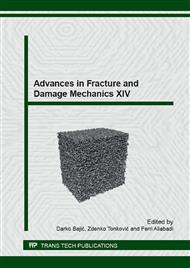p.169
p.173
p.177
p.181
p.185
p.189
p.193
p.197
p.201
Study on the Physical Properties of Recycled Cold Asphalt Using Cementless Binders
Abstract:
In this study, the optimal mixing conditions for recycled cold asphalt, which recycled waste asphalt and used cementless binders, was assessed through verification of the performance. The cementless binder mixing ratio of 6% desulfurization gypsum substitution rate for blast furnace slag was found to have the most outstanding properties. For the Marshall stability, 4% filler mixing brought about a 1.92 times strength increase effect compared to OPC. The flow value testing showed that an increase in the use of asphalt emulsion resulted in an increased flow value while it decreased with the increase in filler substitution rate. The optimal mixing condition that satisfied mechanical performance and durability among the test conditions assessed in this study was found to be 4% filler mixed.
Info:
Periodical:
Pages:
185-188
Citation:
Online since:
September 2015
Authors:
Price:
Сopyright:
© 2016 Trans Tech Publications Ltd. All Rights Reserved
Share:
Citation:


